Medical Batteries Market Statistics, 2032
The global medical batteries market size was valued at $1.4 billion in 2022, and is projected to reach $2.4 billion by 2032, growing at a CAGR of 5.3% from 2023 to 2032. Medical battery manufacturers are anticipated to witness several growth opportunities by producing specialized power solutions that fulfil the stringent government regulations. Implantable medical devices like pacemakers and neurostimulators, for example, require batteries with extended lifespans, tiny form factors, and high energy density.
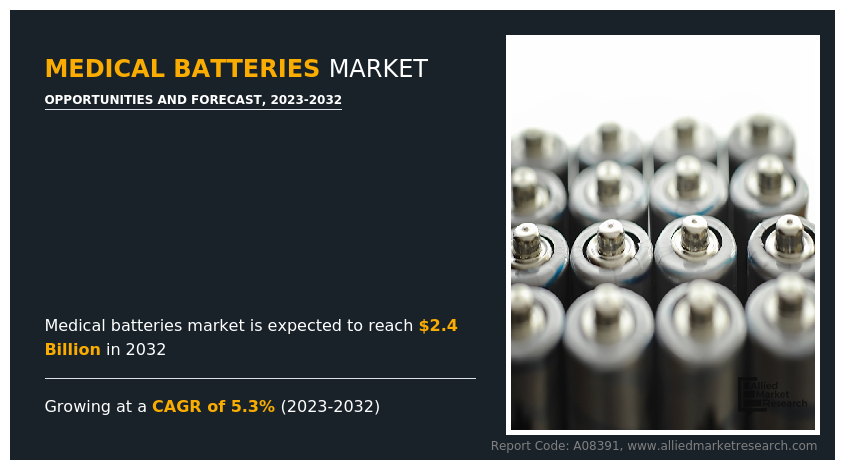
Medical batteries are specialized power sources that are intended to fulfil the specific needs of healthcare applications. These batteries power a wide range of medical devices, from basic portable tools to complicated, life-saving equipment. Medical batteries, unlike regular batteries, are designed with dependability, safety, and lifespan in mind since they are essential to the smooth operation of key healthcare instruments. These batteries are available in a variety of configurations, including disposable and rechargeable alternatives, each customized to the unique requirements of medical equipment and procedures.
The small size of medical batteries is one of their key advantages. Many medical equipment, such as portable infusion pumps, blood glucose monitors, and electronic thermometers, need a power supply that can be easily incorporated. Medical batteries are particularly developed to suit these standards, allowing patients and healthcare professionals to utilize these devices in clinical settings as well as at home. Furthermore, medical batteries frequently provide a continuous and reliable power supply, which is crucial for the precise operation of fragile medical devices. Unlike regular disposable batteries, which may experience voltage variations as they deteriorate, medical batteries are designed to provide a consistent output over their entire lifespan. Furthermore, rechargeable medicinal batteries can be recharged numerous times, due to which they provide a sustainable and cost-effective solution by lowering the need for disposable batteries and minimizing waste. Medical batteries that can be recharged are rapidly being integrated into equipment such as electric wheelchairs, portable oxygen concentrators, and electronic muscle stimulators, providing convenience as well as environmental sustainability.
Medical batteries' size and weight are major issues, particularly with implanted devices. As technology progresses, there is a greater desire for smaller and lighter medical devices. Miniaturizing batteries without reducing their energy storage capacity, remains a significant problem. Implantable devices, such as neurostimulators and medication delivery systems, need small batteries that can fit into small areas within the human body. Balancing the demand for smaller batteries with the necessity for adequate energy storage is a sensitive trade-off that researchers and engineers are still figuring out. The potential of leakage or rupture is a major worry with medicinal batteries. While battery technological developments have minimized these concerns, occurrences of battery failure still occur. A battery leak in the case of implanted devices can have serious implications, causing tissue damage and possibly compromising the patient's life. These factors are anticipated to restrain the medical batteries market size in the coming years.
In medical batteries market, developing batteries that can offer a reliable power supply over an extended length of time without compromising patient safety is critical. Furthermore, the trend towards wearable healthcare technology and remote patient monitoring systems has resulted in a thriving market for medical batteries. The growing use of telemedicine, as well as the requirement for portable, battery-powered diagnostic gadgets, drive up demand for improved medical batteries. Companies who engage in R&D to manufacture batteries with higher energy density, longer cycle life, and greater safety features stand to benefit from this growing market trend. As medical technology advances, device miniaturization becomes increasingly important. Medical gadgets that are smaller and more portable allow for increased patient mobility and comfort.
The key players profiled in this report include Ultralife Corporation, EaglePicher Technologies LLC, EnerSys, Liberating Technologies, Inc., Panasonic Corporation, Tadiran Batteries Ltd., Saft Groupe S.A., Arotech Corporation, SHENZHEN KAYO BATTERY Co., Ltd, and Vitec Group plc. Investments in manufacturing facilities and R&D activities are common strategies followed by major market players. For instance, on April 11, 2022, Resonetics announced the acquisition of EaglePicher Technologies' Medical Power business, a leading manufacturer of implantable batteries for critical medical devices based near Vancouver, British Columbia. EaglePicher Medical Power has been designing and manufacturing batteries for medical devices for over 25 years and produced one of the first lithium-ion cells for an implantable medical device. The Vancouver site features a modern 60,000 square foot facility with extensive application engineering resources and manufacturing expertise.
Segments Overview
The medical batteries market is segmented on the basis of battery type, application, end-user and region. By battery type, the market is divided into lithium-ion batteries, nickel-metal hydride (NiMH) batteries, alkaline batteries, zinc-air batteries, and others. By application, the market is classified into implantable medical devices, non-implantable medical devices, and portable & wearable medical devices. By end-user, the market is classified into hospitals & clinics, home healthcare settings, ambulatory surgical centers, and research institutes. By region, the market is analyzed across North America, Europe, Asia-Pacific, and LAMEA.
By Battery Type
By battery type, the lithium-ion batteries sub-segment dominated the global medical batteries market in 2022. Important advantage of lithium-ion batteries in the medical industry is their rechargeability. Lithium-ion batteries can be recharged hundreds or even thousands of times, lowering both operational costs and the environmental effect of battery disposal. This is especially beneficial for extensively used medical equipment since it reduces the need for frequent battery changes.
Furthermore, lithium-ion batteries have a very flat discharge curve, which means they deliver a steady voltage output for most of the discharge cycle. This characteristic is critical for medical equipment that require a consistent power source to provide accurate readings and precise operation. Power supply consistency is especially vital in critical applications like pacemakers and automated external defibrillators, where accurate electrical impulses are critical for patient safety and well-being.
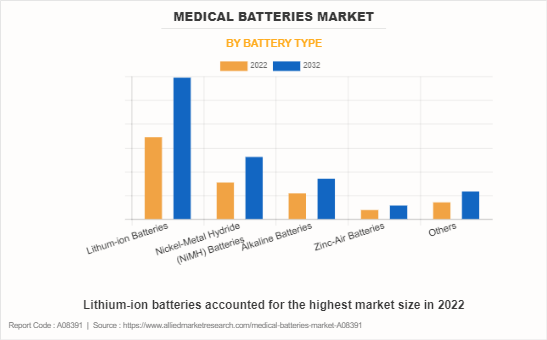
By Application
By application, the implantable medical devices sub-segment dominated the global medical batteries market share in 2022. Developing and implementing innovative battery technology for implanted medical devices can initially be costly, through the long-term benefits result into cost-efficiency. Fewer equipment replacements, lower hospitalization rates, and better patient management all contribute to total healthcare system savings. Furthermore, the improved effectiveness of these devices may result in fewer problems, decreasing the cost burden associated with treating complications even further. Implantable medical devices can now provide complex monitoring and customization functions thanks to advanced batteries.
The ability to remotely modify device settings and continuously monitor physiological indicators contribute to personalized healthcare. This level of customization guarantees that the therapy offered by these devices stays personalized to each patient's individual needs, optimizing therapeutic outcomes. Implantable medical devices powered by advanced batteries considerably improve the quality of life for those living with chronic conditions. Pacemakers, neurostimulators, and insulin pumps, for example, enable patients to live more normal, active lives by efficiently controlling their diseases. The flawless operation of these devices, enabled by high-performance batteries, allows patients to indulge more better in daily activities.
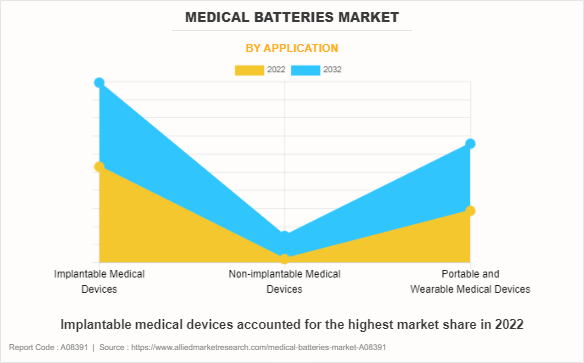
By End User
By end-user, the hospitals & clinics sub-segment dominated the global medical batteries market share in 2022. The incorporation of medical batteries is critical for the smooth operation of sophisticated medical equipment. These technologies, which range from advanced imaging equipment to portable diagnostic kits and telemedicine settings, rely on a consistent and constant power supply. Medical batteries offer compatibility with the most recent healthcare technology, allowing hospitals and clinics to stay ahead of medical advances. As healthcare organizations prioritize sustainability, the use of rechargeable and environmentally friendly medical batteries is consistent with these objectives.
Investing in eco-friendly electrical solutions benefits the environment while also strengthening hospitals' and clinics' reputations in their communities as responsible and forward-thinking businesses. Medical batteries save downtime by providing a dependable backup power source during power outages or planned maintenance. This transforms to higher productivity for healthcare facilities since continuous operation of medical equipment minimizes interruptions in patient care and diagnostic operations. The rising demand for medical batteries in hospitals & clinics is predicted to boost the medical batteries market growth in the coming years.
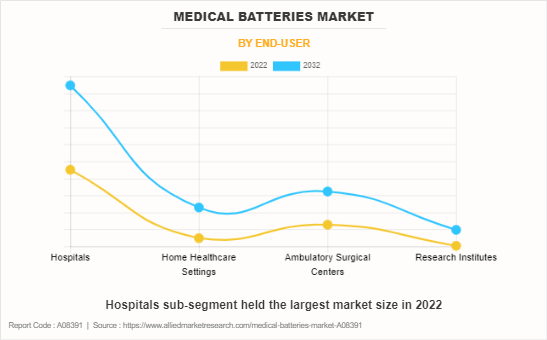
By Region
By region, North America dominated the global medical batteries market in 2022. The fast progress of medical technology is one of the key driving forces behind the rising significance of medical batteries in North America. As medical equipment become more complex and portable, the demand for dependable and efficient power sources increases. Medical batteries supply the energy necessary to keep numerous equipment, such as infusion pumps, heart rate monitors, and glucose monitors, operational in a variety of healthcare settings.
Apart from technological improvements and an increase in chronic illnesses, the emphasis on telemedicine has increased the demand for dependable medical batteries. The trend to remote patient monitoring and virtual consultations necessitates medical gadgets that can operate independently without continual access to a power source. Another key element adding to the need for medical batteries in North America is the introduction of implanted medical devices. These factors are anticipated to have positive impact on North America medical batteries market forecast.
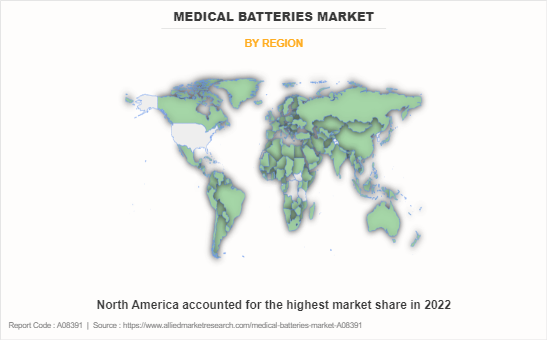
Impact of COVID-19 on the Global Medical Batteries Industry
An increase in demand for portable and remote monitoring equipment was one of the direct effects of the COVID-19 pandemic on the medical battery business. With hospitals overcrowded and limited healthcare resources, there was an increasing demand for equipment that enabled at-home monitoring and telehealth solutions.
- This abrupt shift in emphasis towards decentralized healthcare raised demand for medical batteries capable of powering equipment such as pulse oximeters, portable ventilators, and remote patient monitoring systems. Therefore, manufacturers had the issue of ramping up production to meet an increase in demand, which frequently resulted in supply chain interruptions and delays.
- The pandemic also highlighted the significance of dependable power supplies for crucial medical equipment in emergency scenarios. To maintain the uninterrupted functioning of life support systems and monitoring devices, ICUs (intensive care units) and makeshift medical facilities put up to manage the increase of COVID-19 cases required uninterruptible power supplies. This highlighted the importance of sophisticated, long-lasting medical batteries capable of supplying dependable power in emergency scenarios.
Key Benefits for Stakeholders
- The report provides exclusive and comprehensive analysis of the global medical batteries market trends along with the forecast analysis.
- The report elucidates the medical batteries market opportunity along with key drivers, and restraints of the market. It is a compilation of detailed information, inputs from industry participants and industry experts across the value chain, and quantitative and qualitative assessment by industry analysts.
- Porter’s five forces analysis helps analyze the potential of the buyers & suppliers and the competitive scenario of the market for strategy building.
- The report entailing the medical batteries market analysis maps the qualitative sway of various industry factors on market segments as well as geographies.
- The data in this report aims on market dynamics, trends, and developments affecting the market demand.
Medical Batteries Market Report Highlights
| Aspects | Details |
| Market Size By 2032 | USD 2.4 billion |
| Growth Rate | CAGR of 5.3% |
| Forecast period | 2022 - 2032 |
| Report Pages | 305 |
| By Battery Type |
|
| By Application |
|
| By End-user |
|
| By Region |
|
| Key Market Players | liberating technologies, inc., Videndum plc., Panasonic Corporation, EaglePicher Technologies, LLC, Arotech, Ultralife Corporation., Saft, EnerSys, Tadiran Batteries Ltd., KAYO Battery (Shenzhen) Company Limited |
The medical batteries market size is expected to grow due to an increase in demand for extended battery life and energy efficiency. In addition, the market is driven by growth in smart battery management systems.
The major growth strategies adopted by the medical batteries market players are investments in R&D activities and manufacturing facilities.
Asia-Pacific will provide more business opportunities for the global medical batteries market in the future.
Ultralife Corporation, EaglePicher Technologies LLC, EnerSys, Liberating Technologies, Inc., Panasonic Corporation, Tadiran Batteries Ltd., Saft Groupe S.A., Arotech Corporation, SHENZHEN KAYO BATTERY Co., Ltd, and Vitec Group plc., are the major players in the medical batteries market.
The lithium-ion batteries medical batteries sub-segment of the battery type segment acquired the maximum share of the global medical batteries market in 2022.
Hospitals and healthcare facilities are the major customers in the global medical batteries market.
The report provides an extensive qualitative and quantitative analysis of the current trends and future estimations of the global medical batteries market from 2022 to 2032 to determine the prevailing opportunities.
The growing applications of medical batteries across portable and handheld medical devices such as glucose monitoring system, blood pressure monitor, thermometer, insulin pen, wearable devices, and others are expected to boost the adoption of medical batteries in the upcoming years
Demand for high-performance portable devices, rise in awareness among people about the benefits of medical batteries, and surge in demand for advancements in battery technology to drive the global medical batteries market.
Loading Table Of Content...
Loading Research Methodology...


